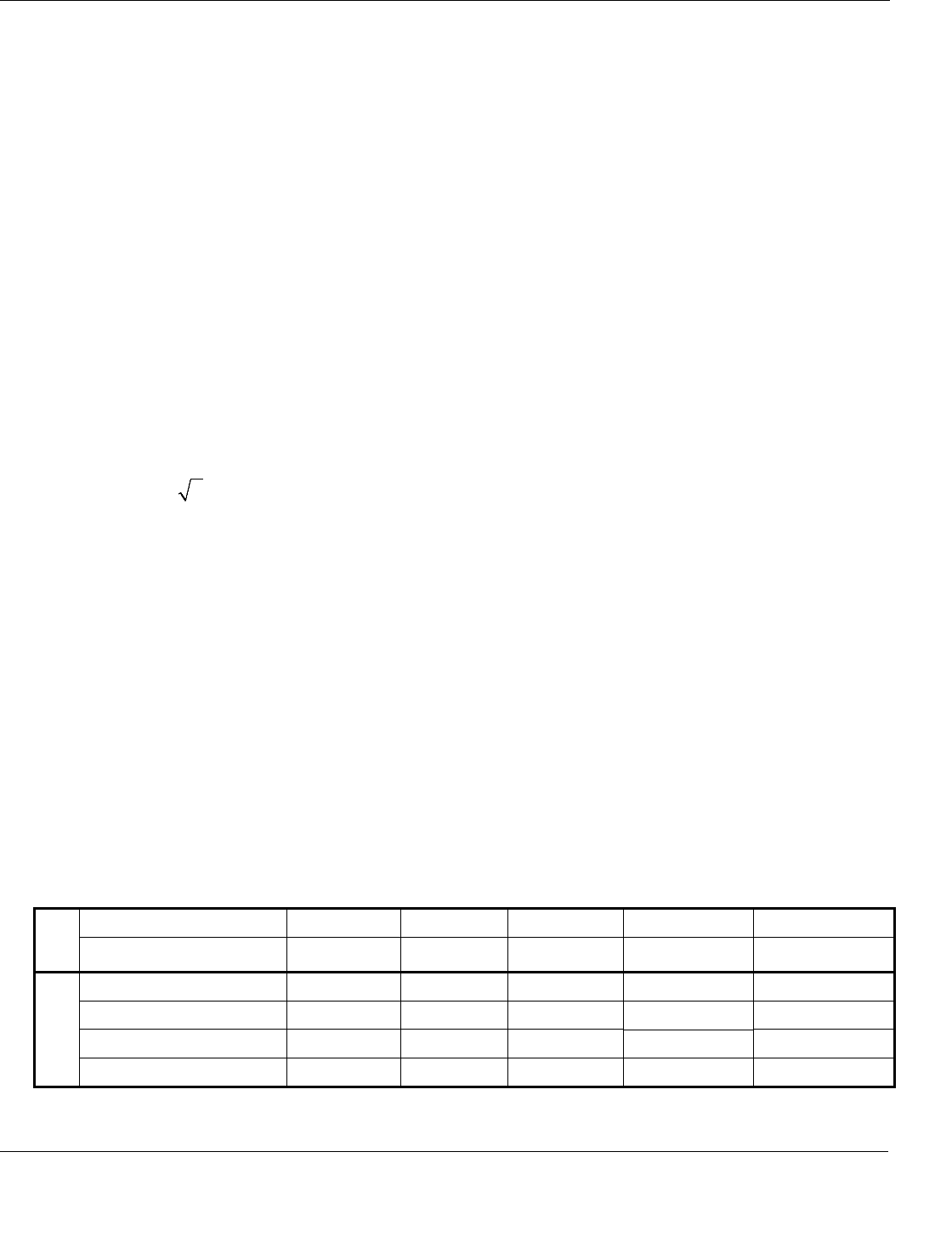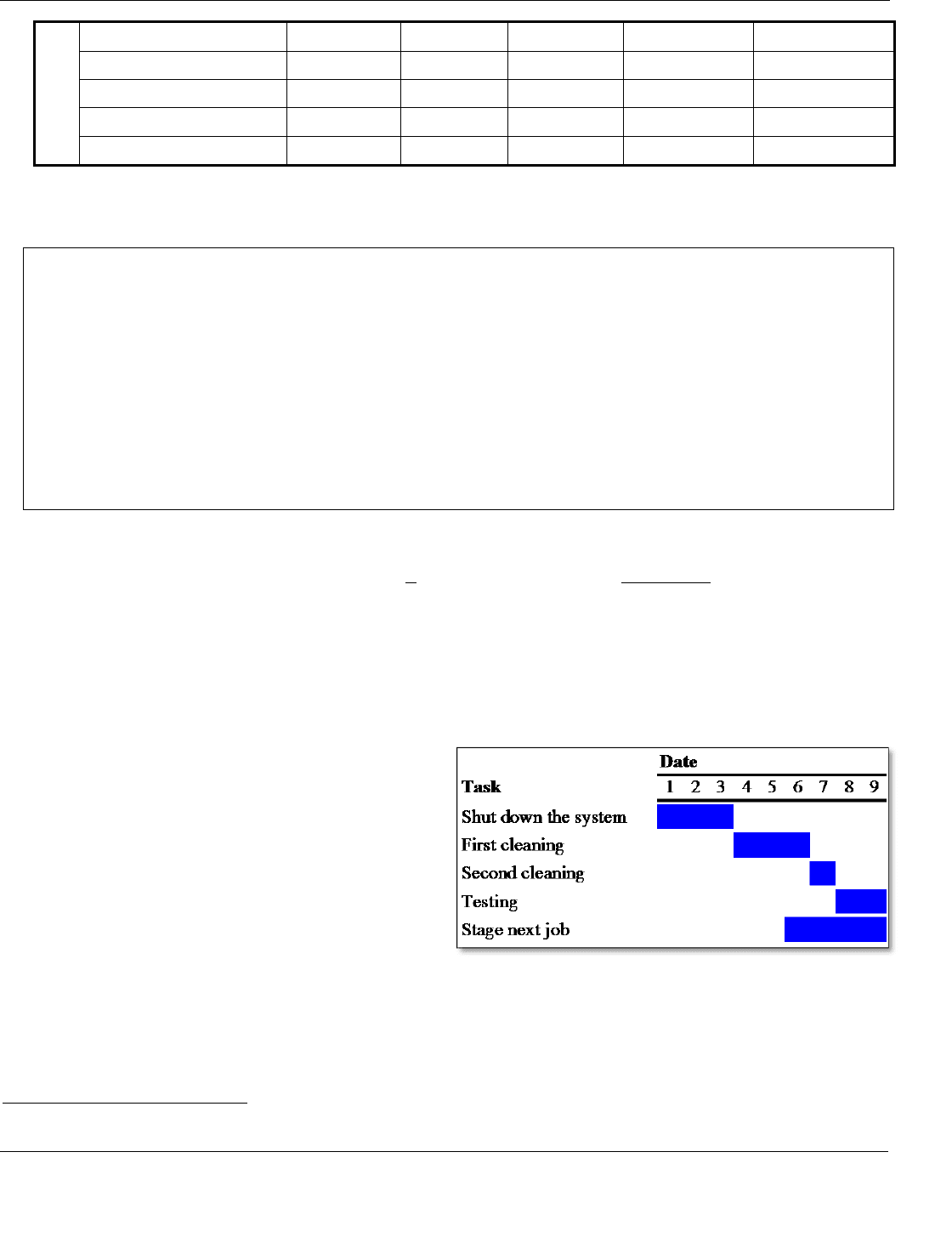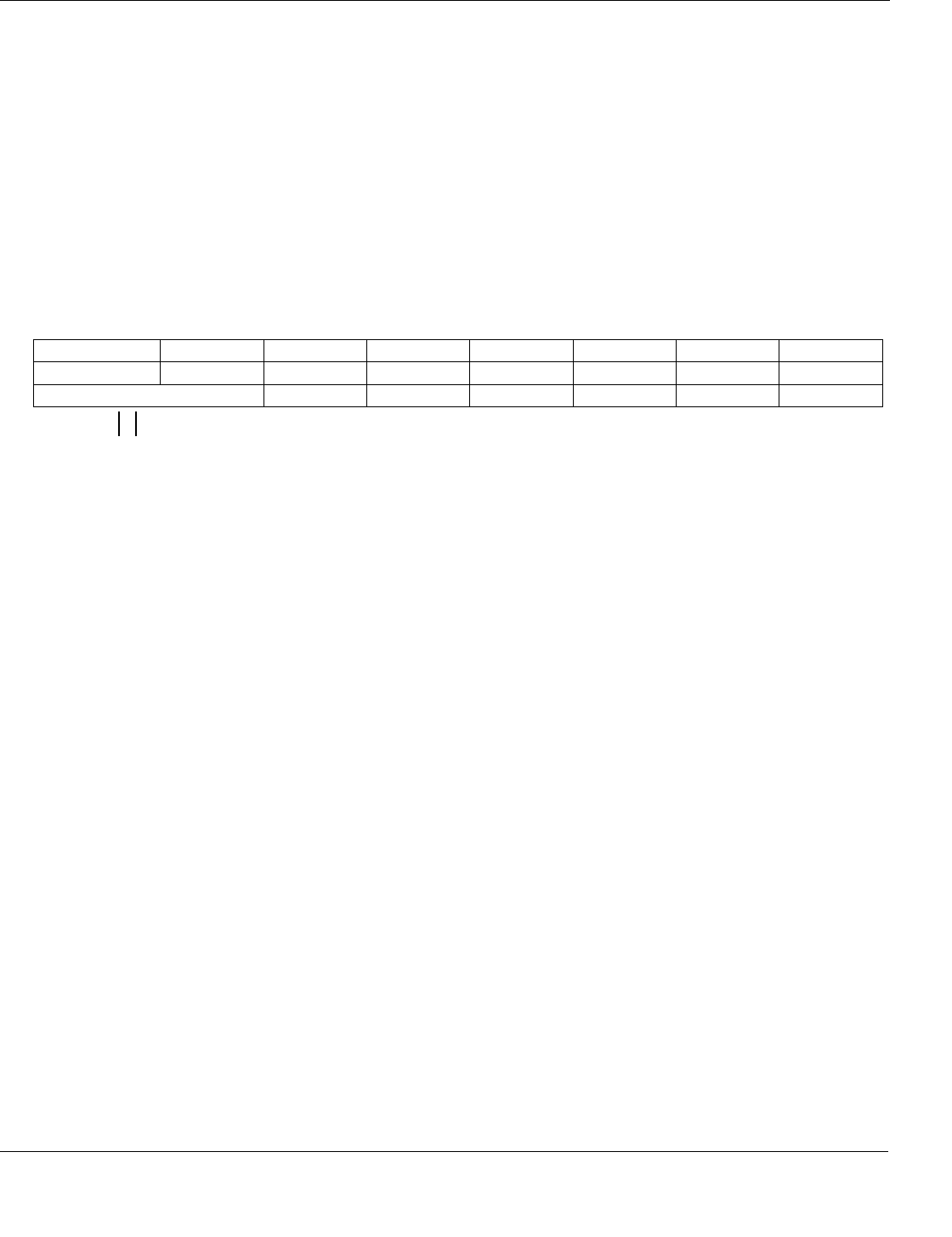Hill A.V. The Encyclopedia of Operations Management: A Field Manual and Glossary of Operations Management Terms and Concepts
Подождите немного. Документ загружается.


ptg6843605
future reality tree – game theory
The Encyclopedia of Operations Management Page 146
For example, a customer order begins with a salesperson who hands it off to order entry, but neglects to
include some information. The order entry person enters the sales order data into the information system, but
accidentally enters the promise date incorrectly. The manufacturing organization makes the product to the
customer’s requirements, but misses one important unusual customer need. The shipping people accidently ship
the product to the billing address rather than to the point of need. It is easy for information to get lost in this
process because each “silo” (department) has different goals and information systems. It is hard for any one
process to “own” this customer order because the process is too far from the voice of the customer.
The lean answer to this issue is to create organizations around value streams that are aligned with market
segments. A focus on value streams instead of silos reduces waste, cycle time, cost, and defects. In the
operations strategy literature, this is called a focused factory.
See Deming’s 14 points, focused factory, lean thinking, mass customization, order entry, value stream.
future reality tree – A theory of constraints term for a type of causal map used to show the relationships needed to
create the future state desirable effects.
See causal map, current reality tree, Theory of Constraints (TOC).
futures contract – An agreement to purchase or sell a commodity for delivery in the future with (1) a price
determined at initiation of the contract, (2) terms that obligate each party to fulfill the contract at the specified
price, (2) the purpose of assuming or shifting price risk, and may be satisfied by delivery or offset; also called
futures.
A futures contract is a standardized, transferable, exchange-traded contract that requires delivery of a
commodity, bond, currency, or stock index, at a specified price, on a specified future date. Unlike options,
futures convey an obligation to buy. The risk to the holder is unlimited, and because the payoff pattern is
symmetrical, the risk to the seller is unlimited. Money lost and gained by each party on a futures contract is
equal and opposite. In other words, futures trading is a zero sum game. Futures contracts are forward contracts,
meaning they represent pledges to make certain transactions at future dates. The exchange of assets occurs on
the date specified in the contract. Futures are distinguished from generic forward contracts in that they contain
standardized terms, trade on formal exchanges, are regulated by overseeing agencies, and are guaranteed by
clearinghouses. To insure that payment will occur, futures also have a margin requirement that must be settled
daily. Finally, by making an offsetting trade, taking delivery of goods, or arranging for an exchange of goods,
futures contracts can be closed. Hedgers often trade futures for the purpose of keeping price risk in check.
See commodity, forward buy, purchasing, zero sum game.
fuzzy front end – The process for determining customer needs or market opportunities, generating ideas for new
products, conducting necessary research on the needs, developing product concepts, and evaluating product
concepts up to the point that a decision is made to proceed with development.
This process is called the fuzzy front end because it is the most unstructured part of product development.
Preceding the more formal product development process, it generally consists of three tasks: strategic planning,
concept generation, and pre-technical evaluation. These activities are often chaotic, unpredictable, and
unstructured. In comparison, the subsequent new product development process is typically structured,
predictable, and formal, with prescribed sets of activities, questions to be answered, and decisions.
Adapted from www.pdma.org (April 18, 2011).
See New Product Development (NPD).
G
Gage R&R – See Gauge R&R.
gainsharing – An incentive program that provides financial benefits to employees based on improvements in
quality or productivity; also called pay for performance.
See Balanced Scorecard, human resources, job design, pay for skill, piece work.
game theory – A branch of mathematics that models the strategic interactions among competitors to determine the
optimal course of action.

ptg6843605
gamma distribution
−
gamma distribution
Page 147 The Encyclopedia of Operations Management
Business can be viewed as a “game” between the competitors in a market. A decision (move) by one player
motivates a move by another player. Historically, game theory can be traced back to the Talmud and Sun Tzu’s
writings. John von Neumann and Oskar Morgenstern are credited with the mathematical development of
modern-day game theory in their book
Theory of Games and Economic Behavior
(Neumann & Morgenstern
1944). In the early 1950s, John Nash generalized these results and created the basis for the modern field of
mathematical game theory
19
. The most widely known example of game theory is the prisoners’ dilemma.
A major issue with game theory is the trade-off between realism and simplicity. The most common
assumptions in game theory are (1) rationality (i.e., people take actions likely to make them happier, and they
know what makes them happy) and (2) common knowledge (i.e., everyone else is trying to make themselves
happy, potentially at our expense).
See co-opetition (co-competition), prisoners’ dilemma, zero sum game.
gamma distribution – A continuous probability distribution often used to model task times and other variables
that have a left tail bounded by zero.
The gamma distribution has shape parameter α and scale parameter β. Important special cases of the gamma
distribution include the exponential, k-Erlang, and chi-square distributions. The k-Erlang is a special case of the
gamma with an integer shape parameter.
Gamma density and distribution functions:
The gamma density function is
1 /
( )
/ ( )
x
f x
x e
for
0x
; ( ) 0f x otherwise, where
1
0
( )
t
t
t e dt
is the gamma function. The gamma function does not
have a closed form when
is not an integer, which means that the gamma density and distribution functions
must be approximated numerically. The gamma function entry presents the VBA code for the gamma function.
Graph:
The graph below shows a gamma density function with a range of
parameters and scale
parameter
= 1. Note that if X is a gamma distributed random variable with shape α and scale 1, then βX is a
gamma distributed random variable with shape α and scale β.
Statistics:
Mean
, variance
2 2
, mode
( 1)
if
1
and 0
otherwise, skewness
2/
, and coefficient
of variation
/c
.
Parameter estimation:
Many authors,
such as Fisher and Raman (2010), use the
method of moments to estimate
2 2
/x s
and
2
/s x
, where
x
and s are the
sample mean and standard deviation. Law
(2007) presented a maximum likelihood
estimation procedure that requires numerical
methods. Minka (2002, p. 2) claimed that
the approach in Law “can be quite slow,
requiring around 250 iterations if α = 10”
and presented an MLE approach that
converges in about four iterations. All MLE
approaches are based on the fact that the
MLE estimate for beta is
/x
.
Excel:
In Excel, the natural log of the gamma function is GAMMALN(
), which means that the gamma
function is EXP(GAMMALN(
)). The gamma density and distribution functions are GAMMADIST(x, α, β,
FALSE) and GAMMADIST(x, α, β, TRUE). The inverse distribution function is GAMMAINV(p, α, β). In
19
John Nash was awarded the Nobel Prize in Economics in 1994 and was the subject of the film A Beautiful Mind in 2001.

ptg6843605
gamma function – gamma function
The Encyclopedia of Operations Management Page 148
Excel 2010, the gamma distribution function is renamed GAMMA.DIST(x, α, β, TRUE), and the gamma inverse
function is renamed GAMMA.INV(p, α, β).
Excel errors: The GAMMADIST and GAMMAINV functions in Excel 2003 and Excel 2007 will return
#NUM for some combinations of input parameters. Knüsel (2005) stateed that the GAMMADIST function “can
have numerical problems just in the most important central part of the distribution.” Evidently, these problems
have been fixed in Excel 2010.
Excel simulation: An Excel simulation can generate gamma distributed random variates with the inverse
transform method using x = GAMMAINV(1-RAND(), α, β).
Partial expectation function:
( ) ( | 1, )
Gamma
H x F x
.
Related distributions: If ~ Gamma(1, )X
, then ~ Exponential( )X
, where
is the mean. If
~ Gamma( , )X k
, then ~ Erlang( , )X k
, where k is an integer. If ~ Gamma( / 2, 2)X k , then
~ Chi-squareX with k degrees of freedom. See Law (2007) for more details. The gamma, Weibull, and log-
normal distributions are special cases of the generalized gamma distribution (Wikipedia 2010). The gamma
converges to the normal distribution as the shape parameter (α) approaches infinity.
See beta distribution, chi-square distribution, Erlang distribution, exponential distribution, gamma function,
inverse transform method, negative binomial distribution, partial expectation, probability density function,
probability distribution.
gamma function – A mathematical extension of the factorial function to real and complex numbers.
The gamma function is
1
0
( )
t
t
t e dt
for
0
. When
is a non-negative integer, ! ( 1)
.
Note that
(1 / 2)
. In Excel, the gamma function can be computed as exp(GAMMALN(x)).
The gamma function is used in several probability distributions, including the beta, F, gamma, chi-square,
and Weibull, and is also useful for evaluating ratios of factorials. The factorial of a positive integer n is defined
as ! ( 1) ( 2) 1n n n n , where
0! 1
. The gamma function generalizes this to all non-negative real
numbers where ! ( 1)
.
The gamma function provides a practical tool for evaluating ratios of factorials, such as n!/m!, that are
common in probability, statistics, and queuing theory. When n or m is large, the factorial results in integer
overflow problems. (The largest factorial that Excel can handle is 170!) Given that !/ ! ( 1) / ( 1)n m n m ,
we know that ln( !/ !) ln( ( 1) / ( 1)) ln( ( 1)) ln( ( 1))n m n m n m . Defining ( ) ln( ( ))GLN x x , then
ln( !/ !) ( 1) ( 1)n m GLN n GLN m and !/ ! exp( ( 1) ( 1))n m GLN n GLN m
. This procedure can be done
in double precision and eliminates the risk of integer overflow problems. However, this procedure can have
rounding problems. This method is comparable to cancelling out common terms in the ratio n!/m! before doing
the division. In Excel, the function for the natural log of the gamma function is GAMMALN(x).
The following table illustrates this point in Excel. From basic algebra, we know that ( 1) !/ !y n n is equal
to
1n
. The table shows that for n = 2, 4, and 169, the factorial and gamma function approaches both provide
the correct values. However, for n > 170, the factorial method has integer overflow problems. In contrast, the
gamma function provides the correct answer within the limits of computer precision.
Table comparing the factorial approach to the gamma approach
Input
data
n
2 3 169 170 3000
Exact answer (n + 1) 3 4 170 171 3001
Factorial
approach
n! 2 6 4.2691E+304 7.2574E+306 Integer overflow
(n + 1)! 6 24 7.2574E+306 Integer overflow Integer overflow
y = (n + 1)!/n! 3 4 170 Integer overflow Integer overflow
Overflow problems No No No Yes Yes

ptg6843605
Gantt Chart
−
gate
Page 149 The Encyclopedia of Operations Management
Gamma function
approach
g
1
= gammaln(n + 1) 0.6931472 1.7917595 701.4372638 706.5730622 21,024.0248530
g
2
= gammaln(n + 2) 1.7917595 3.1780538 706.5730622 711.7147258 21,032.0315539
d = g
2
− g
1
1.0986123 1.3862944 5.1357984 5.1416636 8.0067008
y = exp(d) 3 4 170 ~171 ~3001
Overflow problems No No No No
20
No
Source: Professor Arthur V. Hill
The gamma function has no closed form, but accurate and efficient approximate numerical methods are
available. The following VBA code was written by this author based on the algorithm in Press et al. (2002).
This was tested in Excel and found to be identical to the Excel function GAMMALN() in every case tested.
Function gamma_ln(xx As Double) as double
Dim x As Double, y As Double, tmp As Double, ser As Double, j As Integer
Static cof(0 To 5) As Double
cof(0) = 76.1800917294715: cof(1) = -86.5053203294168
cof(2) = 24.0140982408309: cof(3) = -1.23173957245015
cof(4) = 1.20865097386618E-03: cof(5) = -5.395239384953E-06
x = xx: y = x: tmp = x + 5.5: tmp = tmp - (x + 0.5) * Log(tmp): ser = 1.00000000019001
For j = 0 To 5
ser = ser + cof(j) / (y + j + 1)
Next j
gamma_ln = -tmp + Log(2.506628274631 * ser / x)
End Function
According to Wikipedia, Stirling’s approximation is said to be good for large factorials. However, this
author’s implementation found that it had overflow problems for n > 170. The Wikipedia entry suggests Nemes
approximation as an alternative, where
1 1
ln ( ) ln(2 ) ln ln 1
2 12 0.1 /
z z z z
z z
. The author has
tested this approximation and found it to be very precise for all values of z. Interestingly, the average of the
gamma function approach and Nemes approach was consistently better than either approach in these tests.
See algorithm, beta distribution, beta function, chi-square distribution, combinations, error function,
factorial, gamma distribution, hypergeometric distribution, Student’s t distribution.
Gantt Chart – A graphical project planning tool that uses horizontal bars to show the start and end dates for each
task.
The simple Gantt Chart example on the right
shows the start and end dates for five tasks. Although
a Gantt Chart is a useful tool for communicating a
project schedule (plan), it does not usually show
precedence relationships between tasks and therefore is
not a good project planning tool for large projects.
Microsoft Project, the most popular project
planning software on the market today, uses Gantt
Charts to communicate project schedules. Unlike most
Gantt Charts, this software can use arrows to show
precedence relationships between tasks.
See bar chart, Critical Path Method (CPM), project management, waterfall scheduling.
gap model – See service quality.
gate – See project management, stage-gate process.
20
For n = 170, the Excel value was y ≈ 171.0000000000540; for n = 3000, y ≈ 3001.000000006510.

ptg6843605
gateway workcenter – gemba
The Encyclopedia of Operations Management Page 150
gateway workcenter – The location in a facility where a manufacturing order has its first operation.
See CONWIP, pacemaker.
GATT – See General Agreement on Tariffs and Trade (GATT).
gauge – An instrument used for measurement or testing; also spelled gage.
The word “gauge” is often spelled “gage,” but according to the New Merriam-Webster Pocket Dictionary
(G. & C. Merriam Co. 1971), “gauge” is the proper spelling.
An old management proverb says, “You cannot manage what you cannot measure.” This is particularly true
for managing process improvement. It is impossible to reduce variation in a process (and the products that are
produced by that process) without a reliable measurement system.
Many people assume that the term “gauge” is confined to mean a micrometer, but in the context of Gauge
R&R, the term “gauge” can mean any measurement device. In fact, “Gauge R&R” can be used for any
measurement tool and can even be used for surveys and other non-factory measurement tools. The following list
of common measurement and test equipment includes a broad range of measuring devices:
Hand tools (calipers, micrometers, linear
scales)
Gauges (pins, thread, custom gauges)
Optical tools (comparators, profiles,
microscopes)
Coordinate measuring machines
Electronic measuring equipment (digital
displays, output)
Weights, balances and scales
Hardness testing equipment
Surface plate methods and equipment
Surface analyzers (optical flats, roughness
testers)
Force measurement tools (torque wrenches,
tensiometers)
Angle measurement tools (protractors, sine
bars, angle blocks)
Color measurement tools (spectrophotometer,
color guides, light boxes)
Gauge maintenance, handling, and storage
See Gauge R&R, manufacturing processes, Measurement System Analysis (MSA), metrology.
Gauge R&R – A statistical tool that measures the variation in measurements that arises from (a) measurement
device variability (repeatability) and (b) operator variability (reproducibility); also called Gage R&R.
The measurement system is a key part of understanding and improving process capability and Gauge R&R is
a key part of the measurement system. In many lean sigma and lean manufacturing applications, Measurement
System Analysis (MSA) is conducted in the Measure step of the DMAIC process. MSA is also a key part of the
Control step (the “C”) in DMAIC.
Gauge R&R measures two different types of variation in the measurement process:
• Repeatability – The ability of a device (gauge) to produce consistent results. It is a measure of the “within”
variability between repeated measurements for one device, with one operator, on one part.
• Reproducibility – The ability of the appraiser (operator) to produce consistent results. It is the variation
between different operators who measure the same part with the same device.
In addition, most Gauge R&R studies also measure the interaction between the gauge and the operator. For
example, out of several inspectors, one might have a tendency to read one gauge differently than others.
The two most common methods used for Gauge R&R are the (1) Average and Range method and (2)
Analysis of Variance (ANOVA). The Average and Range method, like many classical SPC methods, is based
on ranges, which are easy to calculate manually. ANOVA is more accurate, but the Range and Average method
is simpler and therefore has been more widely used. With the increased availability of statistical software tools
for ANOVA, it is likely that ANOVA-based Gauge R&R will become the method of choice in the future.
Although the most obvious application of Gauge R&R is for tools, it can be applied to any type of
measurements. For example, it can be applied to customer satisfaction and employee engagement surveys.
Some of the material above was adapted from e-mail correspondence with Gary Etheridge, Staff Engineer at
Seagate, and from the website for the Automotive Industry Action Group (www.aiag.org). DeMast and Trip
(2005) is a good reference on Gauge R&R.
See Analysis of Variance (ANOVA), Design of Experiments (DOE), DMAIC, gauge, lean sigma,
Measurement System Analysis (MSA), metrology, tooling.
gemba – A Japanese term for the actual place where “real” work takes place; sometimes spelled genba.

ptg6843605
gemba walk − geometric mean
Page 151 The Encyclopedia of Operations Management
The Japanese word “gemba” is frequently used for the shop floor or any place where value-adding work
actually occurs. The main idea communicated by the term is that improvement really only takes place with (1)
engagement of the people who work the process and (2) direct observation of the actual current conditions. For
example, standardized work cannot be documented in the manager’s office, but must be defined and revised in
the “gemba.” According to one source
21
, the more literal translation is the “actual spot” and was originally
adapted from law enforcement’s “scene of the crime.”
The Japanese characters are 現場 (from www.fredharriman.com/resources/documents/FHcom_Kaizen_
Terminology_03.pdf (January 27, 2009).
See 3Gs, checksheet, kaizen workshop, lean thinking, management by walking around, waste walk.
gemba walk – See waste walk.
General Agreement on Tariffs and Trade (GATT) – A set of rules created by the United Nations to promote
freer trade by limiting or eliminating tariffs and import quotas between signatory countries.
GATT is now supervised by the World Trade Organization (WTO), which expanded its scope from only
traded goods to include services and intellectual property rights.
See antitrust laws, purchasing, tariff.
genetic algorithm – A heuristic search procedure that finds solutions to optimization problems by generating an
initial solution and then permuting solutions until a stopping condition is found.
See heuristic, operations research (OR), optimization.
geometric decay – See all-time demand, geometric progression.
geometric mean – A measure of the central tendency appropriate for the product of two or more values.
The arithmetic mean (i.e., the average) is relevant for quantities that are added together and answers the
question, “If all quantities had the same value, what value is needed to achieve the same total?” In contrast, the
geometric mean is relevant for quantities that are multiplied together and answers the question, “If all quantities
had the same value, what value is needed to achieve the same product?”
Example 1 – The area of a rectangle can be found by multiplying the length (L) and the width (W). In other
words, A = LW. When L = 10 feet and H = 6 feet, the area is A = 60 square feet. What are the dimensions of a
square with L = W that has the same area? The answer is the geometric mean which is equal to
1/ 2 1/ 2
( ) (10 6) 60 7.746G LW
feet. The arithmetic mean for this problem is (10+6)/2 = 8 feet and the
geometric mean is less than the arithmetic mean (i.e., 7.746 < 8 feet).
Example 2 – The volume of a room can be found by multiplying the length (L), depth (D), and height (H)
together. In other words, V = LDH. When L = 10 feet, D = 12 feet, and H = 8 feet, then V = 960 cubic feet.
What are the dimensions of a room that is a perfect cube with L = D = H that has the same volume? The answer
is the geometric mean, which is equal to
1/3 1/3 1/3
( ) (10 12 8) 960 9.87G LDH
feet. The arithmetic mean
is (10+12+8)/3 = 10 feet and the geometric mean is less than the arithmetic mean (i.e., 9.87 < 10 feet).
Example 3 – The geometric mean is an appropriate measure of the central tendency when an average growth
rate is required. For example, suppose that in three successive years the return on an investment was 5%, 20%,
and −4%. The “average” rate of return for these three years can be found as the geometric mean G = (1.05 ·1.20 ·
0.96)
1/3
≈ 1.065. Therefore, the average rate of return (Compound Annual Growth Rate or CAGR) is 6.5%. To
prove this, we see that 1.065
3
≈ 1.05 · 1.20 · 0.96 = 1.2096. The arithmetic means for these three values is (1.05
+ 1.2 + 0.96)/3 = 1.07, which is more than the geometric mean.
The geometric mean is closely related to the CAGR. If sales grow from s
i
to s
j
over 1
n j i years, the
CAGR during this period is
1/
( / ) 1
n
j i
s s
. For example, if sales grew from $10 to $16 million over a five-year
period, the CAGR during this period is (16/10)
1/5
– 1 = 0.10 or 10%.
The arithmetic mean is
1
n
n i
i
A
x
and the geometric mean is
1/
1/
1 2
1
( )
n
n
n
n n i
i
G x x x x
, where x
i
is
the i-th value and n is the number of values. The geometric mean is always less than or equal to the arithmetic
21
http://elsmar.com/Forums/showthread.php?t=30789, June 14, 2010.

ptg6843605
geometric progression – Global Data Synchronization Network (GDSN)
The Encyclopedia of Operations Management Page 152
mean (i.e.,
n n
G A
). The arithmetic and geometric means are equal (i.e.,
n n
G A
) only if x
1
= x
2
= … = x
n
. The
logarithm of the geometric mean is the arithmetic mean of the log transformed data (i.e.,
1
log( ) (1 / ) log( )
n
n i
i
G n x
).
Excel – Excel uses the function GEOMEAN(number1, number2,...) for the geometric mean. The CAGR can
be computed with the Excel function XIRR(values, dates).
See Compounded Annual Growth Rate (CAGR), forecast error metrics, geometric progression, Internal Rate
of Return (IRR), mean, skewness.
geometric progression – A sequence of terms in which each term is a constant factor times the previous one.
The n-th term in a geometric progression is
1n n
d d
(in recursive form) and
0
n
n
d d
(in closed form).
The
parameter is called the common ratio and is defined as
1
/
n n
d d
. The example below has d
0
= 100
and 0.8
. In this example,
6 5
0.8 32.77 26.21d d
and
6
6 0
26.21d d
(values are rounded).
Term index n 0 1 2 3 4 5 6
Value d
n
100.00 80.00 64.00 51.20 40.96 32.77 26.21
Finite sum, S
n
80.00 144.00 195.20 236.16 268.93 295.14
When
1
, the sum of a geometric progression (a geometric series) has a closed-form expression. The
sum of the first n terms (after term 0) is
2
1 2 0 0 0
... ...
n
n n
S d d d d d d
. Multiplying both sides
by
yields
2 3 1
0 0 0
...
n
n
S d d d
, and then subtracting this new equation from the first one yields
1
0 0
n
n n
S S d d
, which simplifies to
0
(1 ) (1 )
n
n
S d
. Given that 1
, it is clear that
1 0
, which means it is possible to divide both sides by 1
, which yields
0
(1 ) / (1 )
n
n
S d
. At
the limit as
n
,
0
n
and the infinite sum (after term 0) is
0
/(1 )S d
. In summary, the sum of an
infinite geometric progression (starting at n = 1) is
0
/(1 )S d
and the finite sum of the first n terms is
0
(1 ) / (1 )
n
n
S d
. The finite sum from terms m to n is then
1
, 0
( ) / ( 1)
n m
m n
S d
.
For the above example, the infinite sum is
0
/ (1 ) 100 0.8 / (1 0.2) 400S d
and the sum of the
first six terms (after term 0) is
6 6
6 0
(1 ) / (1 ) 100 0.8 (1 0.8 ) / (1 0.8) 295.14S d
.
The initial value (d
0
) is called the scale factor and the constant factor (
) is called the common ratio. The
sequence of values (d
0
, d
1
, …, d
n
) is called a geometric progression and the sum of a geometric progression
(d
0
+ d
1
+ … + d
n
) is called a geometric series. The product of a geometric progression is
( 1)/2
0 1
0
n
n
i
n
i
d d d
if 0
and d
0
> 0.
See all-time demand, exponential smoothing, geometric mean.
geometric series – See geometric progression.
Getting Things Done (GTD) – A philosophy for managing a personal task list, filing system, and e-mails in a
disciplined way; the name of a popular book on personal time management by David Allen (2001).
See the entry for the two-minute rule for what is probably Allen’s most famous principle.
See personal operations management, two-minute rule, two-second rule, tyranny of the urgent.
Global Data Synchronization Network (GDSN) – An initiative designed to overcome product data
inaccuracies and increase efficiencies among trading partners and their supply chains.
GDSN is a network of certified data pools that enable product information to be captured and exchanged in a
secure environment conforming to global standards. Different versions of product information in the supply
chain can cause serious business issues. Global Data Synchronization (GDS) ensures that trading partners

ptg6843605
Global Positioning System (GPS) − goodwill
Page 153 The Encyclopedia of Operations Management
always use the same version of the data. This empowers the supplier to manage the information flow in the
supply chain and not rely on the trading partner or other third parties to manipulate their data. The foundational
principles of GDS include:
Product data is updated consistently between trading partners.
Data is validated against standards and business rules.
Trading partners classify their products in a common, standardized way.
Trading partners have a single point of entry through their chosen data pool, reducing the cost of using
multiple vendors.
The uniqueness of items is guaranteed through the GS1 Global Registry.
The standards body that governs the GDSN is GS1, an organization dedicated to the design and
implementation of global standards and solutions to improve the efficiency and visibility of supply and demand
chains globally and across sectors. The GS1 system of standards is the most widely used supply chain standards
system in the world and has been used for more than 30 years in multiple sectors and industries.
Global Positioning System (GPS) – A satellite-based technology that can be used to determine the current
latitude and longitude for a device.
GPS technology can be a very helpful tool for collecting information in a transportation system.
See logistics, telematics.
global sourcing – See sourcing.
goal tree – See Y-tree.
gold parts – A phrase used in the Theory of Constraints for parts that have passed through the bottleneck.
These parts are much more valuable because the organization has invested time in them from its most
valuable resource (the bottleneck).
See inspection, Theory of Constraints (TOC).
golden zone – See forward stocking area.
Goldratt – See Theory of Constraints (TOC).
Gompertz Curve – See logistic curve.
Good Manufacturing Practices (GMP) – Quality guidelines and general principles for producing and testing
products developed by the U.S. Food and Drug Administration (the FDA) covering pharmaceuticals, diagnostics,
foods, and medical devices; also called Current Good Manufacturing Practices (CGMP).
All guidelines follow the following basic principles:
• Manufacturing processes are clearly defined and controlled. All critical processes are validated to ensure
consistency and compliance with specifications.
• Manufacturing processes are controlled and any changes to the process are evaluated. Changes that have an
impact on the quality of the drug are validated as necessary.
• Instructions and procedures are written in clear and unambiguous language.
• Operators are trained to carry out and document procedures.
• Records are made manually or with instruments that demonstrate that all the steps required by the defined
procedures and instructions were, in fact, taken and that the quantity and quality of the drug was as expected.
Deviations are investigated and documented.
• Records of manufacture (including distribution) that enable the complete history of a batch to be traced are
retained in a comprehensible and accessible form.
• The distribution of the drugs minimizes any risk to their quality.
• A system is available for recalling any batch of drug from sale or supply.
• Complaints about marketed drugs are examined, the causes of quality defects are investigated, and
appropriate measures are taken with respect to the defective drugs and to prevent recurrence.
Adapted from http://en.wikipedia.org/wiki/Good_manufacturing_practice (March 19, 2011).
See process validation, quality management.
goodness-of-fit tests – See chi-square goodness of fit test, Kolmogorov-Smirnov test (KS test).

ptg6843605
goodwill – gray market reseller
The Encyclopedia of Operations Management Page 154
goodwill – (1) In any business context: The value of a good relationship between a business and its customers. (2)
In a business acquisitions context: An intangible asset equal to the cost to acquire a business over the fair market
value of all other assets. (3) In an interpersonal context: A cheerful, friendly, kind attitude toward others.
In any business context, goodwill is the reputational capital of the firm. Goodwill is lost when the
company cannot fulfill its service promises, runs out of inventory, or has poor product or service quality. Lost
goodwill can lead to lost sales, lower margins, and loss of brand equity. Goodwill is very difficult to measure.
In a business acquisition context, goodwill is the difference between the fair market value of a company’s
assets (less its liabilities) and the market price or asking price for the overall company. In other words, goodwill
is the amount in excess of the firm’s book value that a purchaser would be willing to pay to acquire it. If a sale is
realized, the new owner of the company lists the difference between book value and the price paid as goodwill in
financial statements.
See Economic Value Added (EVA), financial performance metrics, quality management, safety stock, service
level, stockout.
GPS – See Global Positioning System (GPS).
gravity flow rack – See flow rack.
gravity model for competitive retail store location – A mathematical model for locating one or more new
retail stores relative to the competing stores in a region.
The basic concept of the gravity model is that the “gravitational pull” for a store on customers is directly
proportional to the size of the store and inversely proportional to the travel time squared. In other words,
customers will be attracted to larger close-by stores much more than they will be to smaller far-away stores. This
model is an application of Newton’s Law, which states that the gravitational pull between two planets is directly
proportional to their mass and inversely proportional to the square of the distance between them.
The goal is to find the best location for one or more new stores from a set of potential locations, assuming
that the new stores will have to compete for customers with the other stores in the region. The model allocates
the revenue in the market to each of the stores based on the “pull,” which is a function of store size (bigger is
better) and travel time (closer is much better). The model can be used to evaluate all reasonable alternatives and
select the store locations that maximize the total expected revenue.
The algorithm allocates all revenue in a region to the m stores. Store j is characterized by its size S
j
and by a
competitive index c
j
, which is used to adjust for weak and strong competitors in the market. The region has n
population areas (census blocks). The travel time from census block i to store j is t
ij
. The “pull” for store j with
competitive index c
j
on census block i is directly proportional to the size of the store and inversely proportional
to the travel time to the ρ power. Pull, therefore, is defined as
/
ij j j ij
pull c S t
. The ρ parameter can be
determined empirically, but is usually close to ρ = 2.
The probability that a resident of census block i will shop at store j is the normalized pull, which is given by
1
ij
ij
m
ik
k
pull
p
pull
. Census block i has m
j
customers with average revenue per customer of r
i
. The expected
revenue for store j, therefore, is
1
n
j
ij i i
i
R p rm
. The best location for a store (or set of stores) can be found by
using the model to evaluate all reasonable alternative configurations and selecting the one that has the largest
expected revenue.
See center-of-gravity model for facility location, facility location, great circle distance, numeric-analytic
location model.
gray market – See gray market reseller.
gray market reseller – A broker that sells products through distribution channels other than those authorized or
intended by the manufacturer; spelled “grey” outside the United States
22
.
22
“Gray” with an “a” is used in America and “grey” with an “e” is used in England and everywhere else outside the U.S.

ptg6843605
great circle distance − green manufacturing
Page 155 The Encyclopedia of Operations Management
Gray market resellers typically buy used equipment or clearance products on the open market and resell
them to end-user customers at prices lower than those desired by the manufacturer. These resellers sell outside
the normal distribution channels, typically have no relationship with the manufacturer, and typically provide no
aftersales service. In some cases, the warranty is no longer valid.
Gray market products are usually (but not always) legal and are usually (but not always) bought and sold at
prices lower than the prices set by the manufacturer or regulatory agency. These are often products that were
sold in one national market and then exported and sold in another national market at a lower price. For example,
a dealer might buy a car at a reduced price in one country and then sell it in another country at a lower price.
See the diversion entry for more information on the problems with this practice.
See broker, diversion.
great circle distance – The shortest distance between any two points on a sphere.
Given that the earth is approximately spherical, the great circle distance can be used to estimate the travel
distance between any two points defined by their latitude and longitude coordinates. Now that Global
Positioning Systems (GPS) and geographical databases are widely available, the great circle distance is a
practical means to estimate distances for a wide variety of logistics and transportation planning problems.
The Spherical Law of Cosines computes the great circle angle (a
ij
) between the points i and j on the earth
using
acos(sin( )sin( ) cos( )cos( )cos( ))
ij i j i j j i
a x x x x y y
, where (x
i
, y
i
) and (x
j
, y
j
) are the latitude and
longitude coordinates for the two points expressed in radians. Convert the great circle angle into a great circle
distance using
ij ij
d r a
, where r is the average radius of the earth, which is r ≈ 3958.76 miles or r ≈ 6371.01
km. If latitude and longitude are expressed in hours, minutes, and seconds (h:m:s), convert them to decimal
degrees using decimal_degrees = h + m/60 + s/60/60, and then convert to radians using radians = π ·
decimal_degrees/180.
The Excel formula for the Spherical Law of Cosines is r*ACOS(SIN(x1)*SIN(x2)+
COS(x1)*COS(x2)*COS(y2-y1)) for earth radius r and coordinates (x1,y1) and (x2,y2) expressed in radians.
When using the arc cosine function (ACOS), the absolute value of the argument must be less than one. It is
useful, therefore, to implement this distance function in VBA to conduct this check. The following VBA code
developed by this author implements the Law of Cosines great circle distance function in VBA using a derived
arc cosine. It is important to use double precision for all variables in this code.
Global Const pi As Double = 3.14159265358979
Function distf(ByVal x1 As Double, ByVal y1 As Double,
ByVal x2 As Double, ByVal y2 As Double) As Double ' input lat/long data in decimal degrees
Const r_miles As Double = 3958.76 ' average radius of the earth in miles.
Dim a As Double
' convert decimal degrees to radians for lat/long coordinates (x1, y1) and (x2, y2).
x1 = CDbl(x1 * pi / 180): y1 = CDbl(y1 * pi / 180): x2 = CDbl(x2 * pi / 180): y2 = CDbl(y2 * pi / 180)
a = Sin(x1) * Sin(x2) + Cos(x1) * Cos(x2) * Cos(y2 - y1) ‘apply law of cosines
If a < -1 Then a = -1 ' the argument for the arc cosine cannot be less than -1.
If a > 1 Then a = 1 ' the argument for the arc cosine cannot be greater than 1.
distf = Atn(-a / Sqr(-a * a + 1)) + pi / 2 ' compute the arc cosine of a in radians.
distf = r_miles * distf ' convert radians to miles.
End Function
The above VBA code finds that the distance between Seattle (47:36:00,122:20:00) and Miami (25:45:00,
80:11:00) is 2732.473 miles and the distance between the Nashville International Airport (N 36°7.2’, W
86°40.2’) and the Los Angeles International Airport (N 33°56.4’, W 118°24.0’) is 1793.555 miles.
Love, Morris, and Wesolowsky (1988) suggest inflating intracity travel distances by a factor of roughly 1.18
to account for the fact that travel distances between intracity points is, on average, greater than the straight-line
distance due to road structures.
See facility location, gravity model for competitive retail store location, Manhattan square distance,
numeric-analytic location model.
green belt – See lean sigma.
